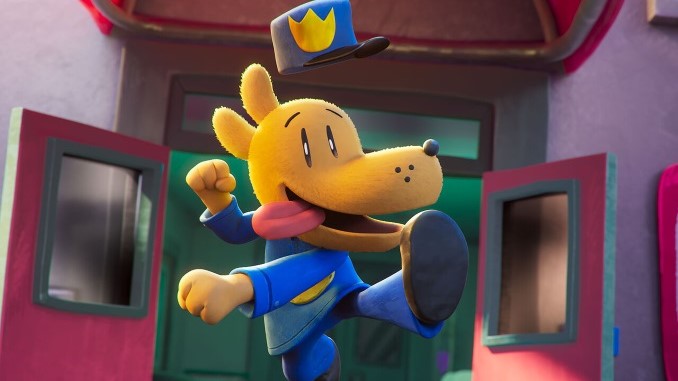Dog Man Is a Sweetly Silly Cartoon That Knows Itself

There are plenty of obvious reasons why Dav Pilkey’s Dog Man graphic novels – cartoon books, really, in the parlance of the 1980s newspaper-strip compilations they sometimes resemble despite an overarching plot – are so popular with kids. They’re deeply silly, colorful, easy to read, and have some built-in branding as a spinoff from the popular Captain Underpants books. On a more subliminal level, though, maybe Dog Man has some extra appeal because it resembles a child’s obsessive art project spun out of control. The character originated as a comic book made by George and Harold, the best-friend child heroes of Captain Underpants, presented in a style-within-a-style that slightly distorts the look of Pilkey’s original books. Over the past decade or so, Dog Man has inspired even more books than there are Underpants installments, in addition to its own spinoff-within-a-spinoff called Cat Kid Comic Club. The goofy in-universe passing obsession for its characters has become genuine lore for its readers.
Now the movie version of Dog Man makes not so much as a reference to its Captain Underpants origins or its supposed child authors; no explanation is required for its scribbly, appealingly blocky form of CG animation. It has achieved escape velocity and runs off-leash.
This lends Dog Man, the movie version, a form of bizarre purity. Though it springs from DreamWorks Animation (who also made a Captain Underpants feature some years ago), and shares with other DreamWorks cartoons a certain fast-yapping freneticism, this is not one of those animated movies that keeps throwing in asides designed to assure parents in the audience, or even older kids who may be questioning their presence at an animated movie, that they’re seen. Nor is this playing in the old Looney Tunes style, where slapstick and wiseass remarks are presumed as a universal language more than a kiddie distractor, even though writer-director Peter Hastings has plenty of experience in that area as a former Animaniacs staffer. There are the merest traces of that sensibility, as when Dog Man winkingly borrows (and cleans up) catchphrases from two R-rated action movies. But most of the time, this movie is making jokes for kids (and, in the now-invisible framing, pretending that they’re by kids). Adults may happen to find some of them funny. Others, like swapping in cutesy terms like “supa” for “super” (e.g., Dog Man is a “supa-cop”; we’ll get to that), may come off more baffling or irritating. The movie is blessedly unconcerned, which in this case is not the same as pandering.
According to my fourth-grade sources, the movie version adapts multiple Dog Man books, which also frees it from the obligation of devoting 90 minutes to an origin story. It takes mere minutes to establish that Officer Knight, a dim-witted cop, and his faithful and clever police dog Greg, get exploded by a criminal, damaging both of them beyond repair. A savvy nurse comes up with a solution: Put the dog’s head onto the man’s body, resulting in a new police officer called Dog Man. (Here, perhaps, a thought is spared for the adults accompanying their young charges to the film: Lingering any further on this medical experiment – speculating about what happens to the cop’s head, specifically, after it’s seen speaking from behind bandages – might disturb them.) Dog Man then becomes his city’s foremost “supa-cop,” fighting crime in all forms, particularly the dastardly cat Petey (Pete Davidson).
-

-

-

-

-

-

-

-

-

-

-

-

-

-

-

-

-

-

-

-

-

-

-

-

-

-

-

-

-

-

-

-

-

-

-

-

-

-

-

-








































